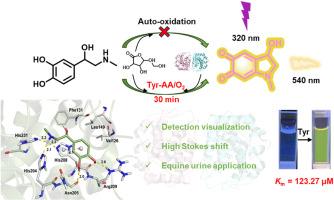A novel tyrosinase-ascorbate system for fluorescence detection of equine doping adrenaline
IF 4.2
3区 工程技术
Q2 CHEMISTRY, APPLIED
引用次数: 0
Abstract
The artificial enhancement of equine athletic performance through pharmacological agents remains a critical concern in racing and other equine sports, threatening both animal welfare and the fairness of competition. Adrenaline, a controlled substance in equine doping, enhances explosive power and masks fatigue, yet its detection remains challenging due to its chemical instability and the limitations of conventional mass spectrometry methods. Herein, we report a simple and sensitive fluorescence-based detection strategy using a tyrosinase-ascorbic acid system to improve Ad stability and enable rapid quantification. In this system, TYR efficiently oxidizes Ad to adrenochrome, a fluorescent product with strong yellow-green fluorescence and a large Stokes shift (220 nm), allowing high signal-to-noise detection. And it exhibits excellent sensitivity with a detection limit of 0.69 μM and high selectivity over structurally similar catecholamines. Furthermore, the tyrosinase-ascorbic acid system successfully detects Ad in complex biological matrices, including untreated equine urine, under physiological pH and temperature conditions. This study introduces a practical and innovative fluorescence-based platform for rapid Ad detection, offering a promising alternative to traditional doping assays in equine sports.

一种新的酪氨酸酶-抗坏血酸荧光检测系统
在赛马和其他马类运动中,通过药物人工增强马的运动表现仍然是一个关键问题,威胁到动物福利和竞争的公平性。肾上腺素是马兴奋剂中的一种受控物质,可以增强爆发力,掩盖疲劳,但由于其化学不稳定性和传统质谱方法的局限性,其检测仍然具有挑战性。在此,我们报告了一种简单而敏感的基于荧光的检测策略,使用酪氨酸酶-抗坏血酸系统来提高Ad的稳定性并实现快速定量。在该系统中,TYR有效地将Ad氧化为肾上腺素色素,这是一种具有强黄绿色荧光和大Stokes位移(220 nm)的荧光产物,可以实现高信噪比检测。对结构相似的儿茶酚胺具有较高的选择性,检测限为0.69 μM。此外,酪氨酸酶-抗坏血酸系统在生理pH和温度条件下成功检测复杂生物基质中的Ad,包括未经处理的马尿。本研究介绍了一种实用和创新的基于荧光的快速Ad检测平台,为马运动中传统的兴奋剂检测提供了一个有希望的替代方案。
本文章由计算机程序翻译,如有差异,请以英文原文为准。
求助全文
约1分钟内获得全文
求助全文
来源期刊

Dyes and Pigments
工程技术-材料科学:纺织
CiteScore
8.20
自引率
13.30%
发文量
933
审稿时长
33 days
期刊介绍:
Dyes and Pigments covers the scientific and technical aspects of the chemistry and physics of dyes, pigments and their intermediates. Emphasis is placed on the properties of the colouring matters themselves rather than on their applications or the system in which they may be applied.
Thus the journal accepts research and review papers on the synthesis of dyes, pigments and intermediates, their physical or chemical properties, e.g. spectroscopic, surface, solution or solid state characteristics, the physical aspects of their preparation, e.g. precipitation, nucleation and growth, crystal formation, liquid crystalline characteristics, their photochemical, ecological or biological properties and the relationship between colour and chemical constitution. However, papers are considered which deal with the more fundamental aspects of colourant application and of the interactions of colourants with substrates or media.
The journal will interest a wide variety of workers in a range of disciplines whose work involves dyes, pigments and their intermediates, and provides a platform for investigators with common interests but diverse fields of activity such as cosmetics, reprographics, dye and pigment synthesis, medical research, polymers, etc.
 求助内容:
求助内容: 应助结果提醒方式:
应助结果提醒方式:


